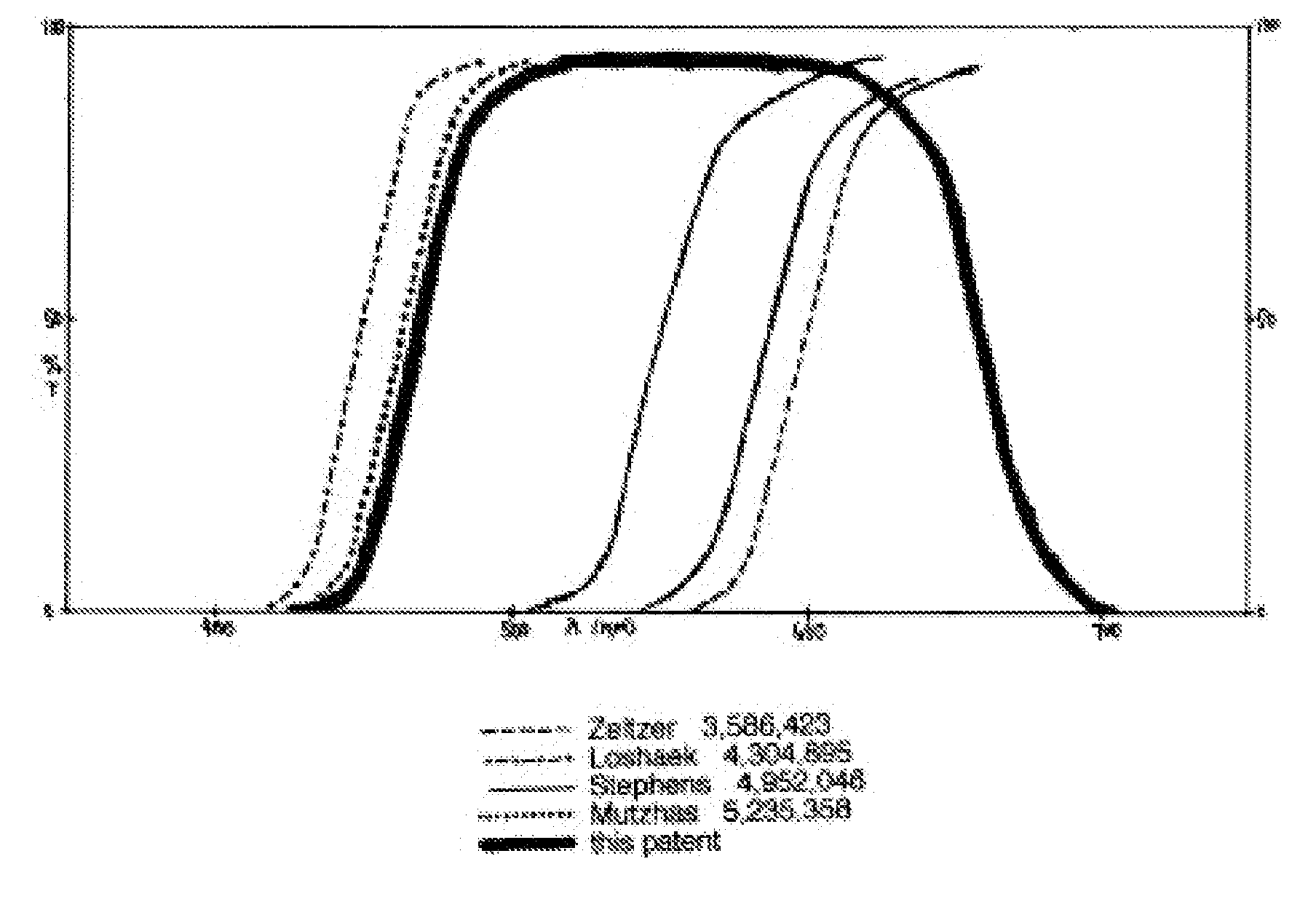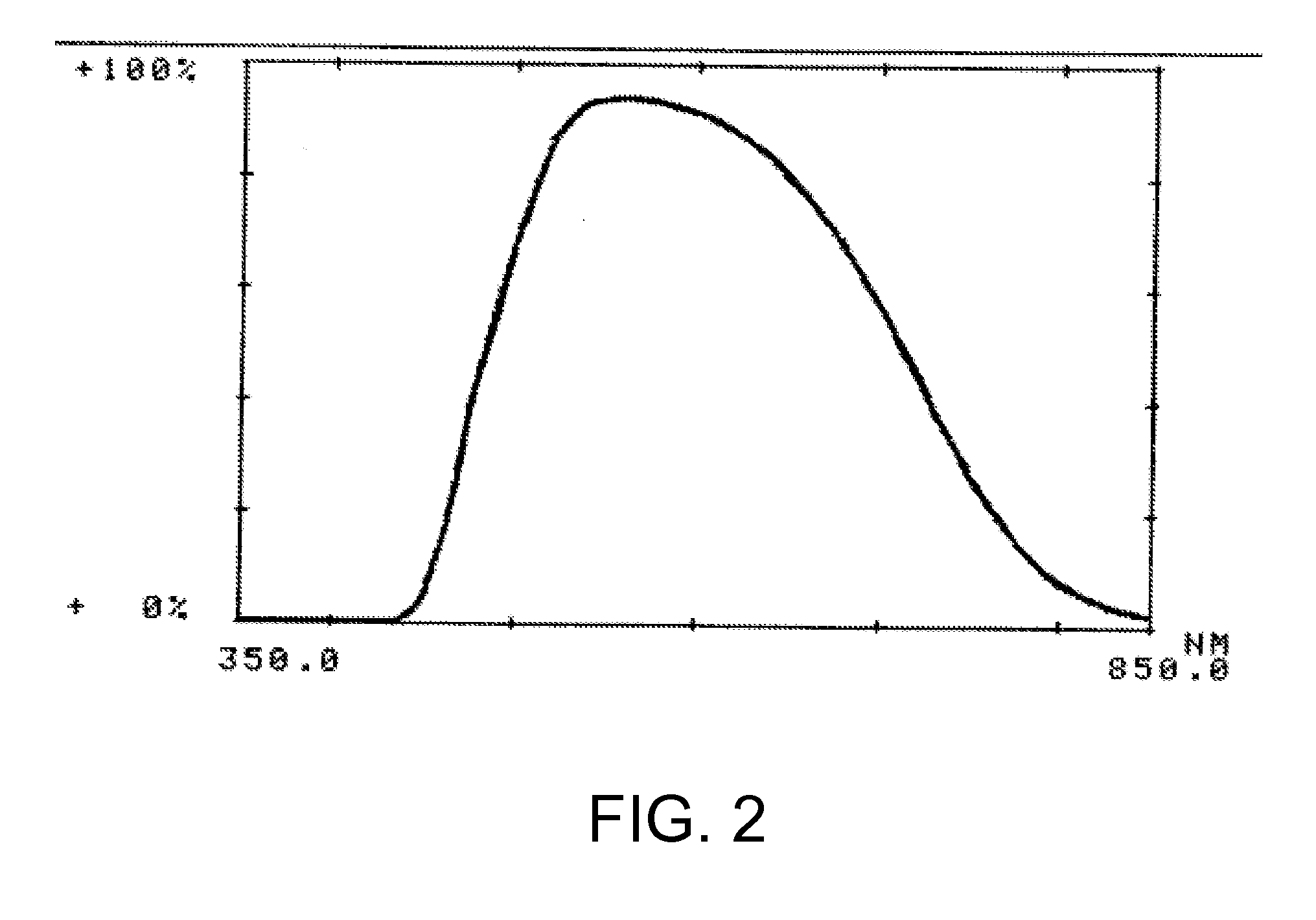Optical devices with reduced chromatic aberration
a technology of optical devices and aberration, applied in the field of optical devices, can solve the problems of not allowing chromatic aberration, unable to achieve the limit of 20/08 vision with currently available lens materials, and reacting reactive dyes chemically with the lens surface, etc., to achieve the effect of improving oxygen permeability, improving stability or strength of optical devices
- Summary
- Abstract
- Description
- Claims
- Application Information
AI Technical Summary
Benefits of technology
Problems solved by technology
Method used
Image
Examples
example 1
A PMMA (polymethyl methacrylate) contact lens or IOL material
[0041]Formulation (% by weight):
MMA, methyl methacrylate monomer, polymer base96.9EGD, ethylene glycol dimethacrylate, crosslinker1.21HMEPB, UV absorber1.50Epolight 2057, IR absorber0.18Solvent Yellow 18, blue light absorber0.08AIBN, 2,2-azobisisobutyronitrile, initiator0.03V-70, 2,2′-azobis(4-methoxy-2,4-dimethylvaleronitrile), initiator0.10HMEPB: 2-(2′-hydroxy-5′-methacryloxyethylphenyl)-2H-benzotriazole
[0042]The MMA and EGD were inhibitor free. The components were stirred until dissolved, filtered and degassed. The mixture was poured into polypropylene molding tubes and the tubes capped. The tubes were placed in a water bath maintained at 20° C. for 12 hours. Polymerization occurs during this time period. The tubes were then placed in a laboratory oven at 50° C. for four hours. After cooling to room temperature, the polymer rods were removed from the molding tubes. The polymerized rods were hard and dark yellow green in...
example 2
A fluoro-silicone-acrylate RGP contact lens material (Dk 60)
[0043]Formulation (% by weight):
MMA, methyl methacrylate monomer, polymer base12.0TFEM, trifluoroethyl methacrylate, oxygen permeability26.0EGD, ethylene glycol dimethacrylate, crosslinker6.08MMA, methacrylic acid, wetting agent6.0TRIS monomer, oxygen permeability source38.4TRIS dimmer, oxygen permeability and crosslinking9.6HMEPB, UV absorber1.5Epolight 9151, IR absorber0.18Solvent Yellow 18, blue light absorber0.08AIBN, 2,2-azobisisobutyronitrile, initiator0.04V-70, 2,2′-azobis(4-methoxy-2,4-dimethylvaleronitrile), initiator0.12HMEPB: 2-(2′-hydroxy-5′-methacryloxyethylphenyl)-2H-benzotriazoleTRIS: 3-methacryloxypropyltris(trimethylsiloxy)silaneTRIS DIMER: 1,3-bis(3-methacryloxypropyl)tetrakis(trimethylsiloxy)disiloxane
[0044]The MMA, TFEM, MM and EGD were inhibitor free. The components were stirred until dissolved, filtered and degassed. The mixture was poured into polypropylene molding tubes and the tubes capped. The tube...
example 3
A silicone-hydrogel soft contact lens material (water content 40%, Dk 75)
[0045]Formulation (% by weight):
DMA, N,N-dimethylacrylamide, hydrophilic polymer base50.0TRIS monomer, oxygen permeability source30.0TFEM, trifluoroethyl methacrylate, oxygen permeability17.46EGD, ethylene glycol dimethacrylate, crosslinker0.5HMEPB, UV absorber1.5Epolight 91 51 , IR absorber0.20Reactive Yellow 86, blue light absorber0.10AIBN, 2,2-azobisisobutyronitrile, initiator0.06V-70, 2,2′-azobis(4-methoxy-2,4-dimethylvaleronitrile), initiator0.18HMEPB: 2-(2′-hydroxy-5′-methacryloxyethylphenyl)-2H-benzotriazoleTRIS: 3-methacryloxypropyltris(trimethylsiloxy)silane
[0046]The DMA, TFEM and EGD were inhibitor free. The components were stirred until dissolved, filtered and degassed. The mixture was poured into polypropylene molding tubes and the tubes capped. The tubes were placed in a water bath maintained at 20° C. for 12 hours. Polymerization occurs during this time period. The tubes were then placed in a labo...
PUM
 Login to View More
Login to View More Abstract
Description
Claims
Application Information
 Login to View More
Login to View More - R&D
- Intellectual Property
- Life Sciences
- Materials
- Tech Scout
- Unparalleled Data Quality
- Higher Quality Content
- 60% Fewer Hallucinations
Browse by: Latest US Patents, China's latest patents, Technical Efficacy Thesaurus, Application Domain, Technology Topic, Popular Technical Reports.
© 2025 PatSnap. All rights reserved.Legal|Privacy policy|Modern Slavery Act Transparency Statement|Sitemap|About US| Contact US: help@patsnap.com



